One of the most striking facts of American politics today is the contrast between the political failure of conservative economic policy ideas at the national level and their relative success in state and local politics. That doesn’t just mean that there are a lot of Republican governors. It also means that some of the more popular and successful Democratic governors—New York’s Andrew Cuomo, say—have a lot in common with their GOP counterparts on economic issues, even while differing sharply on gay rights and gun control and such.
Some of this you can chalk up to the fact that the electorate in midterm elections is more conservative, but I think it holds true nonetheless, and there are lessons for both parties in it.
The biggest one, however, is what a difference the tax base makes. The mildly progressive structure of federal income tax rates plus high and rising levels of income inequality have given us a federal government with a very progressive financial structure. State and local governments, by contrast, rely on a tax base that ranges from slightly regressive in some places to wildly regressive in others. So while on the federal level voters famously are against “spending” but actually always want to spend more money on everything, in state and local politics there’s much more focus on the conservative-friendly issue of getting value. Liberals of course can (and do!) try to make the state and local tax base more progressive, but voters and politicians find tax competition arguments—i.e., “We need low income taxes or else entrepreneurs will go to Texas”—more plausible when applied to smaller units than the United States as a whole.
